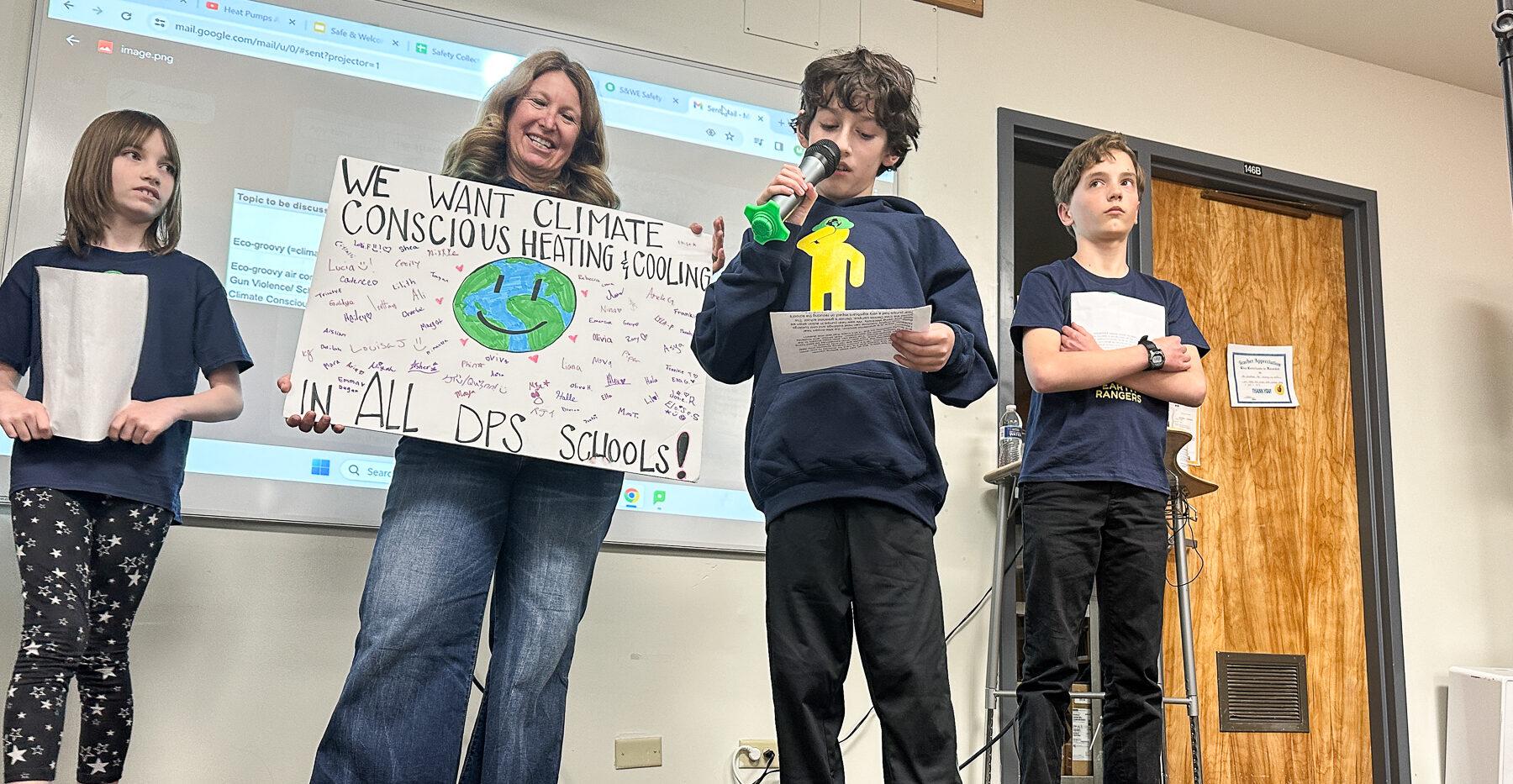Caden O’Kellylee, 12, remembers what it was like sitting in his elementary classroom when temperatures hit 90 degrees for hours a day.
“It’s pretty exhausting,” he said, thinking back to his time at Teller Elementary, one of more than 30 schools in Denver Public Schools without air conditioning. “Sometimes it’s hard to think.”
There was a portable AC unit in the window, “but they were very loud and weren’t very fun to listen to. It was just uncomfortable.”
Denver Public Schools has gradually added traditional AC units to most of the schools. This November, voters may decide on air conditioning for the remaining 30 schools.
When O’Kellylee learned about an efficient way to both heat and cool in the same unit, something called a heat pump, he wondered: “Why don’t we have these?”
O’Kellylee is a member of Earth Rangers, the middle school extension of DPS Students for Climate Action, which is comprised mostly of high school students. They are lobbying for climate-conscious heat pumps to be installed in schools that don’t yet have air conditioning. They hope to get this option on the city’s November ballot.

Get the gas out
“It’s more efficient and it uses electricity instead of fossil fuels,” said Earth Ranger and sixth-grader Halle Jackson.
The kids did their research. Earth Rangers knew that focusing on heating and cooling in their schools would have the biggest bang for the buck. Energizing buildings accounts for 84 percent of DPS’s carbon emissions. Forty-one percent comes from heating through natural gas, said Jackson.
They toured DPS’s Evie Dennis multi-school campus in the city’s northeast. It has solar panels and is heated and cooled using geothermal high-efficiency heat pumps. They take the place of natural gas boilers and traditional air conditioners.

Water is pumped into the ground through a set of large pipes and they split into a series of smaller horizontal pipes, kind of like radiant heating in a home. The pipes then either transfer heat to the ground or absorb heat from the ground.
“The pipes switch back and forth and allow heat exchange,” said Adam West, a DPS energy engineer. “So, you’re either pushing heat into the ground or allowing heat to be exchanged in the ground when you’re in cooling mode — or when you’re in heating mode, you’re absorbing heat from the ground and putting it into the buildings.”
Most schools use natural gas heating and traditional AC units. A heat pump is two in one.

“When the district adds AC, it gives us an opportunity to electrify heating,” West said. “Using electricity to heat our schools allows us to power heating with renewable electricity or carbon-free electricity from the grid.”
Heat pumps are three to five times more energy efficient than natural gas boilers and reduce carbon emissions. The average household saves up to 7.6 tons of carbon emissions a year.
The cost of installing heat pumps can vary compared to AC units depending on the school system, said West. The district currently has about 20 buildings with some use of heat pumps.
More Climate News: How a Colorado scientist wants to slow climate change — one brick and tile at a time
Eco-anxiety is pushing more students into action
Students are asking that when an HVAC system is updated or if new AC systems are installed, the district uses climate-conscious heat pumps. They say that’s consistent with the DPS Climate Policy and the DPS Climate Action Plan, which came about through student advocacy. The plan has a goal to reduce the district’s overall greenhouse gas emissions by 90 percent by 2050 from 2010 levels. One of the key strategies to doing that is eliminating the use of natural gas in DPS buildings.
If you ask any child or youth about climate change, anxiety often comes pouring out. Many of the students in Earth Rangers or DPS Students for Climate Action remember exactly when they realized the depth of the crisis.
At the beginning of the pandemic, O'Kellylee discovered a book in the library on climate change.
“I just couldn't stop,” he said. “I checked out more and more and more and then I realized the problem that we were creating for ourselves to deal with.”
Amelia Fernandez, 16, said she learned about the climate crisis at age 13.
“I knew I had to do something. I started very small.”
She said climate anxiety among youth is very prevalent.
“We are inheriting a crisis that is threatening our very existence, it's threatening the existence of all the creatures that we could coexist with.”

Farah Djama, 17, recalls that when she was 15, she had a lot of climate anxiety. A friend advised her to attend an online conference with The Climate Reality Project. Djama eventually joined DPS Students for Climate Action and advocated for the district’s climate plan, one of the strongest in the nation. She said that the plan can inspire students around the country.
“Thinking back to when I wasn't involved how much anxiety I felt and how powerless I felt. Now I feel a lot more empowered.”
Her school Thomas Jefferson High hasn’t finished installing traditional AC. She remembers sweating and being distracted at the beginning of the school year. She said in the winter, the heating system didn’t work when her friends on the robotics team met on weekends.
“They had to wear parka coats with gloves … that are flammable. And for anyone who works with power tools or electricity, that's a hazard. Someone could get hurt.”
The students have their sights on heat pumps in all DPS schools. They are starting with a first goal of getting heat pumps for the 30 DPS schools that still need air conditioning.
Will heat pumps for schools go before voters?
One recent Tuesday, students showed up to where any child wants to go on a Tuesday night – a DPS Community Planning and Advisory Committee meeting!
The 72-person committee will decide what goes on a potential bond ballot measure this November.
“Electric buildings are the future and we want Denver to lead the way in making that future a reality for school children everywhere,” sixth-grader Oscar Park told the committee.


A cost analysis found that for 13 of the 30 schools, heat pumps would be cheaper than traditional AC. For eight more schools, it’s still cost-effective but would require the district to tap into another fund for an extra $7 million.
The district has proposed spending $247 million to add AC to 21 of the 30 schools. For the remaining nine, the analysis found it would take another $43 million for construction costs.
Fernandez wants heat pumps in all 30 schools. During the CPAC meeting, she asked the district to consider tapping federal tax credits for solar and geothermal through the Inflation Reduction Act, which could help with upfront costs. If the district waits, “it’s just going to make the climate problem worse.”
But the bond is a flat amount, and DPS has a lot of capital needs districtwide. It’s up to the committee to decide next month how to allocate the money.
“I fully understand where students are coming from with saying, ‘let's do all 30 schools,’” said the district’s energy engineer West. “Ultimately, funding schools for climate action can't just be done locally, especially in Colorado.”
He said it would take municipal, state, and federal support. He estimates that changing out 160 plus main school buildings with electrified heating will be a multi-decade effort.

The kids want to see quicker progress
They’re driven to give something back to the Earth instead of destroying it because it gives us so much, said Earth Ranger Park.
“It gives us somewhere to live, it gives us food, it gives us us,” he said. “Without it, we wouldn't exist.”
Right now, they’re focused on getting more youth involved in the bond measure, one cog in the biggest issue of their lifetimes. They’re hoping to grow Earth Rangers (they have fun cheers like the “colossal squids,” one where they yell “chomp chomp!”) to tackle more issues like getting climate and renewable energy issues into the curriculum.
Along with the DPS Students for Climate Action, they are helping host a Climate Summit on Friday, April 19, at East High School from 4 p.m. to 7:30 p.m. All students and community members are invited. It will focus on how students can contribute to climate actions and build leadership and advocacy skills. The keynote speaker is Madhvi Chittoor, 13, the youngest UN child advisor and founder of Madhvi4EcoEthics and the EcoEthics Global Movement.
“If you are a youth right now experiencing eco-anxiety, worrying about the present and the future, you have to know that the only antidote is action,” said Fernandez. “There's no point in wallowing in your own despair.”














